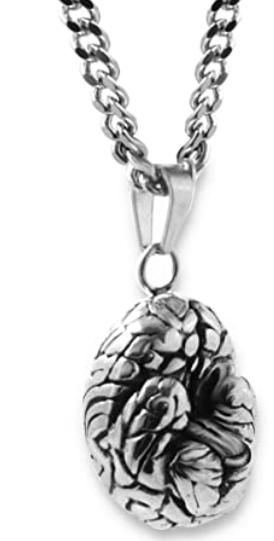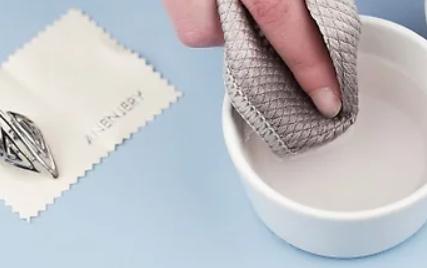Stainless steel jewelry is loved and well recognized for various reasons like rich designs, less expensive, easy maintenance and high durability. But do stainless steel jewelry tarnish or rust over time? When drawn by a piece of stunning stainless jewelry, many people may concern about this question as we want to keep the wishful jewelry for a long time. In this article, we’ll explore these questions in detail.
Anything may rust or tarnish over time due to its materials or exposure to different environments. Stainless steel is no exception, though it’s armed with a layer of chromium to protect against corrosion and may take a long time to develop rust and tarnish. Here we listed 3 common factors that can cause stainless steel tarnish or rust:

Wear & Damages. Typically, the stainless steel used in making jewelry has at least 10% chromium to protect the other metals like nickel, carbon, manganese and iron in the alloy from rust or tarnish. However, this layer of chromium may fail to work over time if you 24/7 wear it from rushing to a train station in the morning to showering at night and sleeping on the bed, or on occasions when your stainless steel jewelry kisses other metal jewelry or abrasive cleaners. The scratches or damages may expose the inner metals to contact with oxygen and other conditions and result in rust or tarnish.
Special Environment. Apart from the layer of chromium, the stainless steel can also develop a protective oxide film in the air to help protect against oxidation, making them far away from rust or tarnish. However, if you live in tropical areas or are keen on playing in the sea or on the beach, it’s better not to always wear them. Otherwise, the protective oxide film may be affected by high chlorides like salt or high moisture in the environment. For instance, the cavities or holes of the stainless jewelry may suffer pitting corrosion, contributing to the loss of its sparkle. What’s more, heavy makeup, sweat or natural oil from our body may also react with the stainless steel, especially the nickel inside, and contribute to tarnish or rust.
Manufacturing Process. When a piece of jewelry is designed to be made by welding two different metals together, the electrolytes and extreme temperatures in the manufacturing process may cause bimetallic, crevice or intergranular corrosion to develop respectively between two metals, the joining surfaces or the boundaries of crystallites, which will increase the risk of rust or tarnish. In these cases, proper maintenance is particularly important.
Though the stainless steel jewelry may get scratched, rust or tarnish, fortunately there are some easy ways to deal with these problems and restore its luster.

Baking Soda. Mix two parts of baking soda with one part of water to create a thick paste, then use a soft toothbrush to scrub and clean the jewelry slowly. Once all rust or tarnish are removed, rinse with warm water and dry it with a soft cloth.
Gel Toothpaste. Toothpaste can also be used in a way similar to baking soda to clean stainless steel jewelry. Just note that don’t use those kinds of toothpaste that may include chemicals like whitening agents as they’re abrasive and harsh.
Soap and Water. Fill a small bowl with warm water and add a bit of mild soap. Soak the stainless jewelry in the bowl and let it sit there for a few minutes. Then dip one corner of a small soft cloth into the soapy water and use the soapy corner to clean the jewelry. When it’s thoroughly cleaned, rinse and dry it up. Then your jewelry will be shiny again.
Ultrasonic Cleaning. This may be the best way to thoroughly clean a piece of jewelry involving intense vibrations to clean those hard-to-reach areas. However, it’s more expensive and may cause damages to the gemstones if any in the jewelry.

Stainless steel is an alloy, but there are thousands of stainless steel varied in properties in practice for various applications. Basically, they can be divided into 4 categories:

Austenitic Stainless Steel - the most frequently used type of stainless steel with a higher level of chromium, non-magnetic, featuring higher corrosion resistance. Our familiar Grade 304 and 316 stainless steel are both of this type, but Grade 304 is widely used in the food industry while Grade 316 is popular in the jewelry industry.
Ferritic Stainless Steel - containing 10.5% to 30% chromium and low carbon content, magnetic, less expensive but highly resistant to stress, corrosion, cracking and temperature oxidation, often used in high-duty industrial applications.
Duplex Stainless Steel - a combination of austenitic and ferritic stainless steel, lighter and stronger than both, ideally used in underwater work and marine applications.
Martensitic Stainless Steel - the least common type of stainless steel, lower corrosion resistance but higher hardness, and renowned for applications of medical and surgical instruments.
To wrap up, stainless steel jewelry, containing at least 10% chromium, is normally resistant to corrosion, scratches, wear and tears, but its property may change if exposed to harsh conditions like high chlorides or moisture environment. In these cases, we can use some easy ways to clean them and restore their luster in daily life.
Yes, the gold plated stainless steel jewelry will tarnish or rust over time, because the gold plating is usually very thin or of low quality. They will wear out over time, expose the metal underneath in the air and result in tarnish or rust.
It depends. Usually, the stainless steel won’t turn your skin green or any other colors as the chromium on top makes it durable enough to resist discoloration or tarnish. But if you’re allergic to metals or often wear heavy makeup, the chemicals from our body or cosmetics may slowly react with the stainless jewelry and turn the skin green over time. So, you may wonder why some jewelry turns your skin green.
The stainless steel is designed to rust, tarnish and discoloration resistant. But how long it will last actually depends on the quality of stainless steel and the environment they’re exposed to. Usually, they can last over a hundred years with proper care.
This is the question that first-timers ask every time- does getting your ears pierced hurt? Here’s the lowdown on what happens when getting your ears pierced.
Read MoreDo men wear engagement rings? Is it appropriate for the gentleman to wear them after the proposal’s acceptance? In this today’s topic, I’ll discuss some of the facts you should know and other considerations.
Read MoreDo you often want to change to different styles of rings? But buying many expensive rings is not very realistic. Come and see, cute cheap rings may be right for you.
Read MoreDiscover the unique his or her bracelets to let the romance blossom. If you have no ideas which bracelet is best for your partner and you, here are the 10 different styles of couple bracelets to help you find the unique one to show affection.
Read More